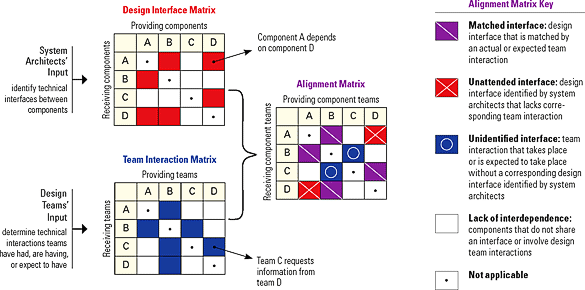Application of Alignment Matrix in Project Coordination and Communication
Every big project involves a large diverse group of people working and collaborating together towards common objectives, goals or deliverables. This results in complex relationships of tasks and people. One of the key aspects of managing such complex relationships is ensuring that the people/teams are communicating effectively. In order to do that, it is first and foremost necessary to understand the network and the interdependency between teams. This is where the tool Alignment Matrix plays a role.
This aim of this article is to explain the tool and its applications. It will draw upon the key findings from the Pratt and Whitney project in order to provide Project Managers with insights by which they can monitor their effectiveness in communication with the intention of learning and improving for future projects. Lastly, the advantages and limitations will be reflected upon.
Contents |
Background of the tool
An Alignment Matrix is a recently developed new application of a project management tool, Design Structure Matrix (DSM). DSM is nothing but a compact, matrix representation of a system or project. It is a powerful tool that helps visualize the interactions, exchange of information and dependency patterns between sub-systems (INSERT REF). Thereby, allowing to carry out analysis, project planning, and organizational design.
It was developed to aid managers between different sub-system development teams in identifying key areas where planned communication failures could occur. The idea is to enable This is possible by mapping unattended and unidentified interfaces of technical communication. The application was primarily developed in a product development context based on the study of Pratt and Whitney’s development of their jet engine PW4098. The development of a jet engine, just like most sophisticated products, involves several sub-teams working on different components that make up the engine. In the PW4098 case, there were 54 sub components, each having its own design and developemnt team.
Applications in Project Management
In theory, the application of the tool is pretty straightforward and simple. All it involves is mapping first the areas in the matrix where communication should be occurring. Secondly, mapping the areas where communication is actually taking place. Finally, overlapping the two to find areas which are not common to both matrices. Those areas indicate the planned communication that is failing to take place or unplanned communication which should have been aware of.
In practice, however, the above theory translates into massive amounts of data collection in order to be able to fill up the two matrices. Researchers, who developed this tool used interviews to collect this data. They followed the below steps.
The first step in the process of applying the tool is having the system architect identify and list all the different subsystems and their interdependencies involved. The next step is to create a matrix where those interdependencies are then mapped. For the application discussed here, the system architect would most likely be the project manager or the management team that put together the project. It is here, where the data collection is required to complete the mapping process.
The last step is aligning the two matrices to conduct the analysis of unplanned and unidentified communication. The outcome is an excellent graphical representation of how well communication activities are taking place and provides the insights into where the focus should be directed in order to improve the project functioning.
Critical reflection
limitations: Identifying the different teams in order to create the matrix can be a challenge especially when you have people working in multiple groups or where the organizational structure is not clearly defined. It does not necessarily benefit the current project and hence it may not improve the current communication challenges of a project. Applying the tool can be a tedious task of noting all the departments, identifying interfaces, plotting and so on and will mostly require the time of the system designer which is many cases is the project manager. It is also intensive on resources as it involves interviews with different team members. It does not necessarily the linkage to the organizational structure and hence causes for communication may not necessarily be identified.
Advantages This tool could be a good complementary tool to feedback surveys and reviews. It, however, does create an awareness about the vital communication points which could set the path for critical thinking while sharing information. It also does massively improve communication in similar projects in the future and hence from a portfolio point of view, it is worth the resources. It also provokes managers to be more critical in deciding the information to share with adjacent departments.
References
- Are Are Your Engineers Talking to One Another When They Should?, Manuel E. Sosa, Steven D. Eppinger and Craig M. Rowles, article from Harvard Business Review,
- An Introduction to Modeling and Analyzing Complex Product Development Processes Using the Design Structure Matrix (DSM) Method, Ali A. Yassine
